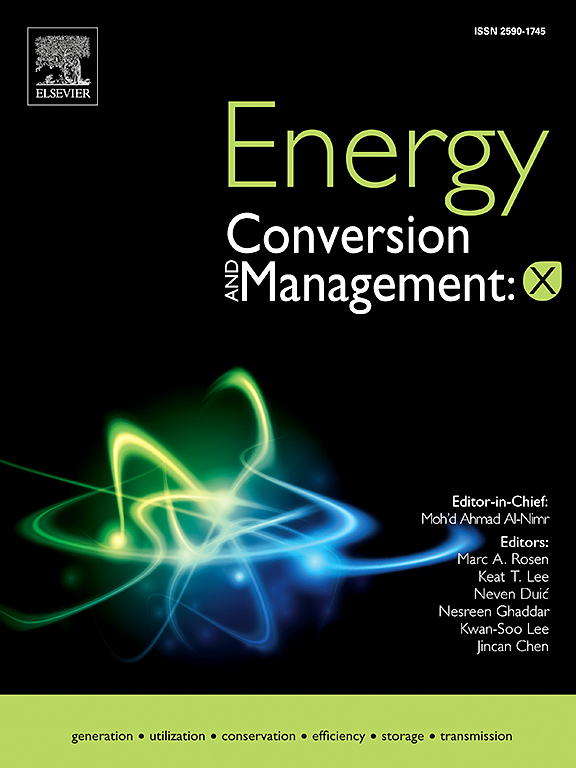Optical and thermal analysis of an extended compound parabolic concentrator integrated with photovoltaic thermal system using different heat sink configurations
IF 9.9
1区 工程技术
Q1 ENERGY & FUELS
引用次数: 0
Abstract
This study models an extended compound parabolic concentrator-photovoltaic thermal (ECPC-PVT) system of a 2.5X concentration ratio, integrating a homogeniser to improve solar flux distribution and a heat sink configuration to manage surface heating. The study provides insights into optimizing ECPC-based PVT systems by adjusting heat sink geometry and cooling fluid parameters. Two heat sink configurations, square and circular risers with hydraulic diameters ranging from 6 mm to 16 mm, are examined for their optical and thermal performance. The Monte Carlo ray-tracing (MCRT) method is used to analyse the solar flux distribution on the ECPC receiver throughout the day from morning 7 h to evening 16 h (10/22/2024). The finite volume method (FVM) is employed to assess the photovoltaic cell temperature using ANSYS Fluent 2021 R1. Results show that the square heat sink configuration outperforms the circular configuration. The system achieves a maximum average solar flux and an optical efficiency of 1383.62 W/m2 and 84.67 %, respectively. The peak outlet temperatures for square and circular risers at 16 mm are 318.41 K and 317.63 K, respectively. The maximum thermal efficiencies are 51.02 % for the square riser and 48.85 % for the circular riser, while the corresponding exergy efficiencies are 2.94 % and 2.80 %. Increasing the mass flow rate increases thermal efficiency but reduces outlet temperature and exergy efficiency. The maximum power efficiency for the square riser and circular riser is 16.30 % and 15.960 %, respectively.
采用不同散热片结构的复合抛物聚光器集成光伏热系统的光学和热分析
本研究模拟了一个2.5倍浓度比的扩展复合抛物型聚光光伏热(ECPC-PVT)系统,该系统集成了一个均质器来改善太阳通量分布,以及一个散热器配置来管理表面加热。该研究为通过调整散热器几何形状和冷却流体参数来优化基于ecpc的PVT系统提供了见解。两种散热器配置,方形和圆形立管,液压直径范围从6毫米到16毫米,对其光学和热性能进行了测试。利用蒙特卡罗射线追踪(MCRT)方法分析了ECPC接收机从早晨7 h到晚上16 h(2024年10月22日)全天的太阳通量分布。利用ANSYS Fluent 2021 R1软件,采用有限体积法(FVM)对光伏电池温度进行评估。结果表明,方形散热器结构优于圆形散热器结构。该系统最大平均太阳通量为1383.62 W/m2,光效率为84.67%。方形立管和圆形立管在16 mm处的出口温度峰值分别为318.41 K和317.63 K。方形立管和圆形立管的最大热效率分别为51.02%和48.85%,相应的火用效率分别为2.94%和2.80%。增大质量流量可提高热效率,但降低出口温度和火用效率。方形立管和圆形立管的最大功率效率分别为16.30%和15.960%。
本文章由计算机程序翻译,如有差异,请以英文原文为准。
求助全文
约1分钟内获得全文
求助全文
来源期刊

Energy Conversion and Management
工程技术-力学
CiteScore
19.00
自引率
11.50%
发文量
1304
审稿时长
17 days
期刊介绍:
The journal Energy Conversion and Management provides a forum for publishing original contributions and comprehensive technical review articles of interdisciplinary and original research on all important energy topics.
The topics considered include energy generation, utilization, conversion, storage, transmission, conservation, management and sustainability. These topics typically involve various types of energy such as mechanical, thermal, nuclear, chemical, electromagnetic, magnetic and electric. These energy types cover all known energy resources, including renewable resources (e.g., solar, bio, hydro, wind, geothermal and ocean energy), fossil fuels and nuclear resources.
 求助内容:
求助内容: 应助结果提醒方式:
应助结果提醒方式:


